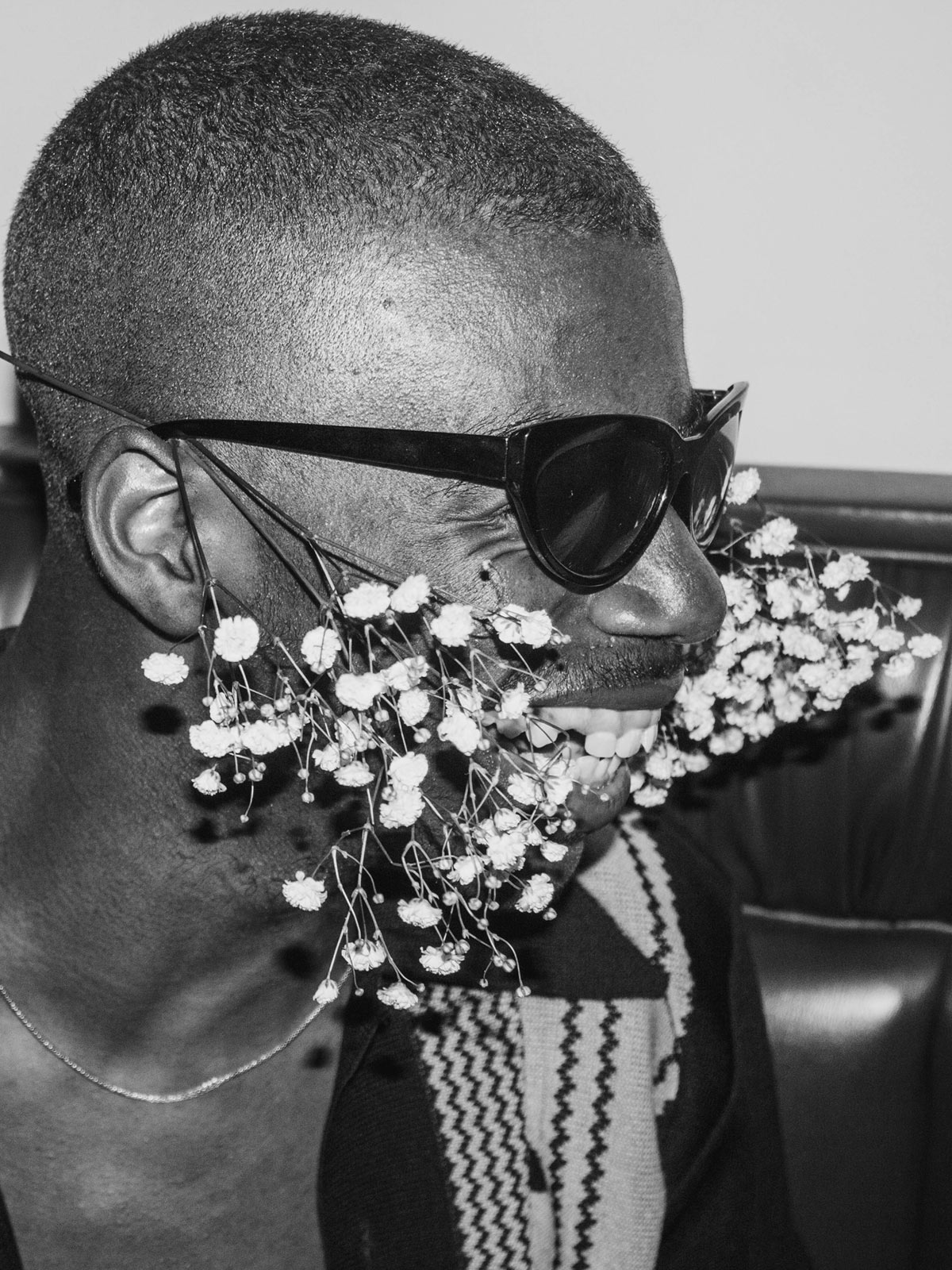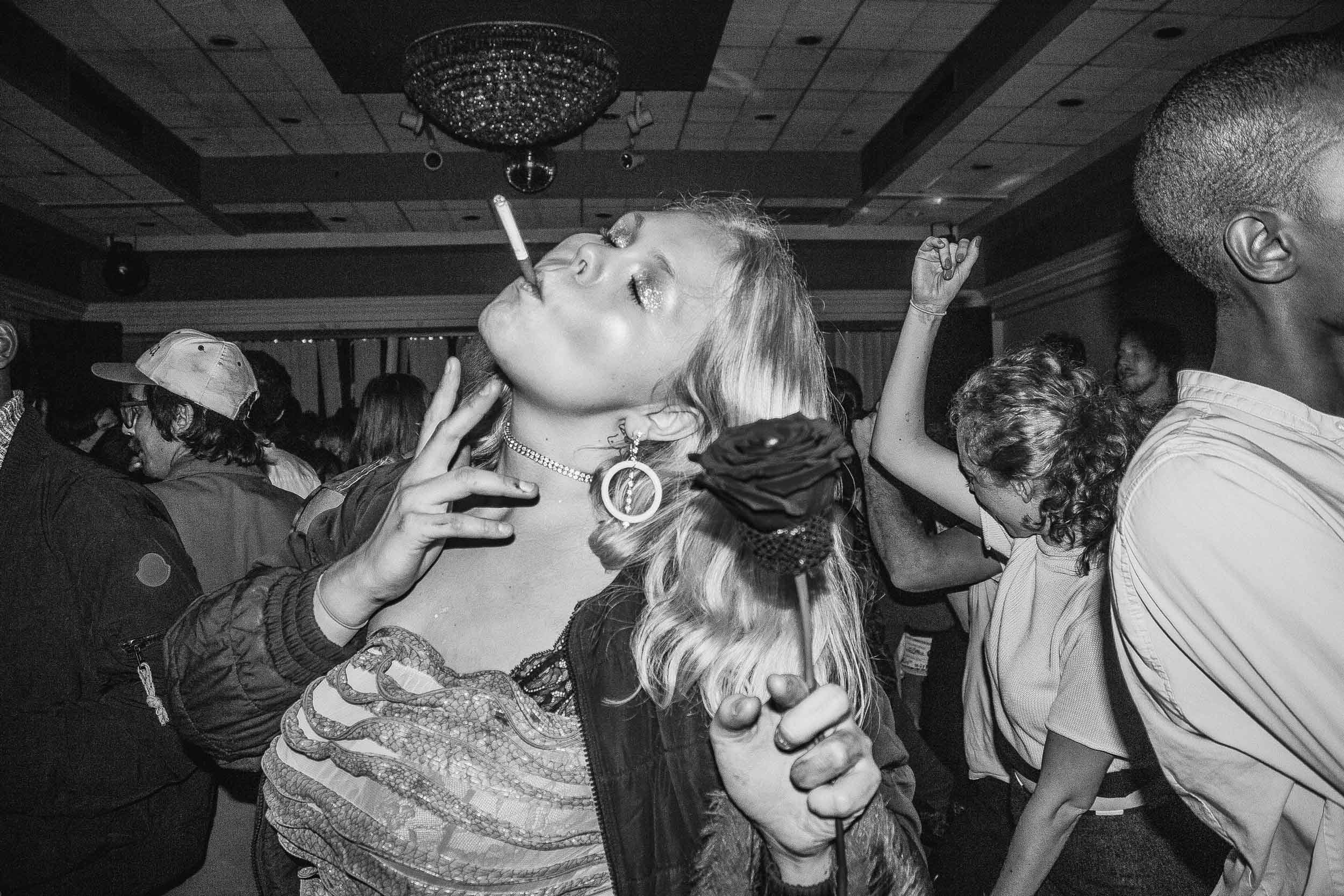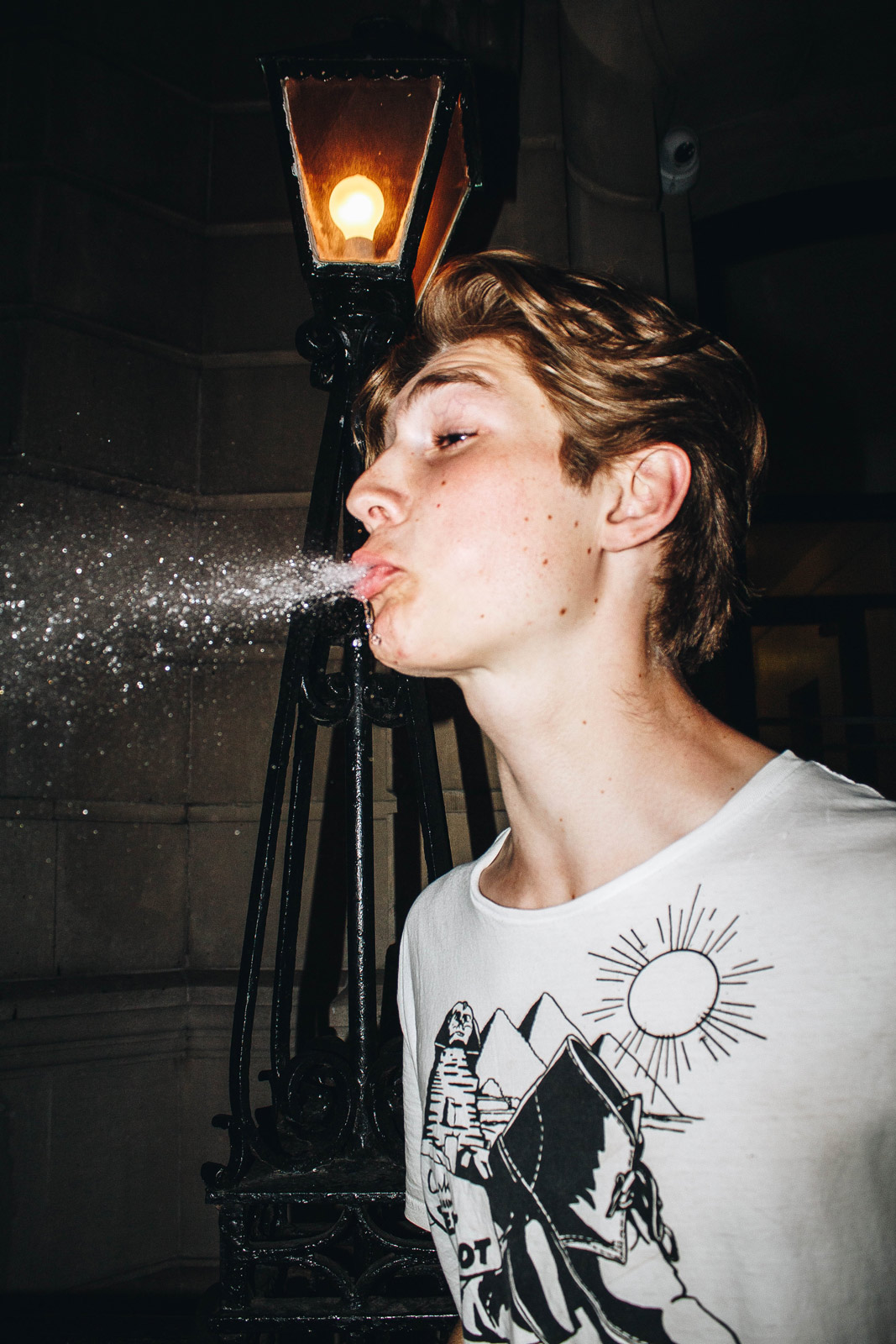In his new exhibition, 'Go Home,' the photographer captures fleeting moments of vulnerability and human connection
Tyrell Hampton’s first photography exhibition, Go Home at SN37 Gallery at the Seaport in Manhattan, is his love letter to the fantastical New York City nightlife he once only experienced through television and film. Made from 2016 to the present, the timeless black and white images capture moments in time that are otherwise forgotten as the daylight arises the next day. Disco balls taking the place of the night sky, an exhale of cigarette smoke, a shared laugh in the corner booth, and kissing (tons of kissing) exist as intimate pieces of a whole: the night out. Once the new kid in town, observing nightlife from a somewhat voyeuristic perspective, Hampton now finds a home in the nocturne of the city’s clubs, a community based in human connection. The world through his eyes exudes joy and energy, inviting everyone to join the party.
Ryan Williams: Congratulations on the show. It’s really exciting. New York City is a main character in your work, and I was wondering if you could tell me a little bit about when you first fell in love with the city. How did you know this was ultimately where you wanted to be and wanted to move to?
Tyrell Hampton: I think I fell in love with the city when I first came and I saw The Lion King. I think I was about maybe 10 or 11. We went to Times Square, and then we went back home, but, I think that was the moment when I was just like, ‘This is where I need to be.’ It felt so freeing. I wasn’t following my mom around. I was getting lost, but it was just so nice to get lost in such a big place. I felt like it was bigger than me and ahead of me. I felt that if I lived here, if I was a part of this community or the city, then it would make me feel big in a way too.
Over time, watching certain TV shows and music videos and movies, like Gossip Girl and Sex and the City, I think I ultimately fell in love with the idea that this place could be something that’s so fantastical and, in a way, unreal. It shouldn’t be real that the things that are happening here are happening here. Like, you walk down the street, you’re singing in the rain…Just being able to maneuver through the city in such a grownup way, I didn’t think that would happen to me. Then I moved here for school and, like, it all happened so suddenly.
Ryan: Do you have a favorite depiction of the city, whether it’s realistic or not, that just sticks out in your brain?
Tyrell: Studio 54 or, like, the ’70s in New York City.
Ryan: I wonder if you can speak to how, with Go Home, you are creating a depiction of the city that might inspire other young artists, or anyone really, to fall in love with New York and dream of moving here.
Tyrell: I think I’m continuing the message that I saw when I was younger. It was when I saw those [Studio 54] images of people having fun and people being vulnerable in a way that was so new to me that made me want to move here. I want to continue that message of creating imagery or work that is about my community and about people being vulnerable. That was a huge part of the show in general—picking things that I felt as though people could relate to, actions that people could relate to, or the sort of people that they’re around that they can relate to.
Ryan: When it came to curating your first show, in addition to finding these relatable moments, how did you go about it? Did how you approach photographing night life blend into this process as well?
Tyrell: The show is basically laid out like moments that I would look for in a party. The first thing you see when you walk into the show is a photo of a ceiling with disco balls. I called it Balloons, ’cause they look like balloons to me. But I feel like I wanted to guide the viewer, or the patron coming into the show, through how I view the world, in a way—which is, like, looking up at the sky and looking up at the people around me. There’s a ‘kiss wall’ in [Go Home] of people making out and people in love. People dancing on the dance floor, people having conversations that I’m not necessarily a part of but it looks so passionate. The way the show was made, what you actually see [is] what I see in a club.
Ryan: With technology, there’s often a negative connotation to living life through our phones and experiencing [it] through our screens. There is that instant gratification or instant critique that we do. When you go out, do you balance shooting with experiencing the night? As you grow in this space, becoming less voyeur and more participant, has that changed the way you photograph nightlife?
Tyrell: Not necessarily. I still keep the same rituals of image-making when I go out. I never have been the person that is taking a bunch of images. I think it’s more so about when I find this moment or situation that I’m really attracted to. Finding that moment and then just letting that moment happen in front of me and documenting that moment.
The person smoking a cigarette, I’ve never smoked a cigarette. So I’m, like, living vicariously through the person. I’m documenting them taking that inhale and exhale that breath. Most people know that feeling of when you take that first pass or when the smell comes out and it’s such a relief. So when I go through parties it is more about the things that I’m really attracted to. I usually find maybe four or five situations in a night that I really am attracted to. And then I’ll have four or five images from that night.
Ryan: With your work centered around these intimate moments and human connection, how did the lockdown and being separated from the rest of the world affect you?
Tyrell: I always liked photographing people who were comfortable with each other. Throughout the past couple of years, it’s been interesting how I haven’t really had to rely on going to the club. It’s more so about, again, the sense of community and finding situations where people know each other. A big thing that I did when we were really in lockdown was skating. I would go for walks with my friend where we would just witness the city, and it was so quiet. We’d watch how teenage boys would go out and skate and then you’d see a group of girls at the park, like, reading. Those situations are so intimate and vulnerable at the same time. They may not relate to being in a club, but in the same sense, it’s about someone being vulnerable and being a part of their community and sharing a space with someone that they feel comfortable with.
Ryan: Do you think the nightlife scene has changed through the pandemic, even now, as we’re coming out of it?
Tyrell: I think I’m seeing a revamped nightlife right now. I’m definitely seeing a new nightlife. I had a feeling that we were going to come out of the situation with a new perspective on how we see community and how we see going out. I feel like a lot of people are trying to go out as much as they can, ’cause they maybe took it for granted or they felt it would always be there.
Ryan: In a similar vein, nights themselves usually must end, though live on through your images. Your title Go Home reminds me of that. Why that title?
Tyrell: I love satirical or funny, quirky captions and titles. And I felt like Go Home was about how people go home in, like, Berlin at like 5pm the next day. And here, sometimes, it could be 5am or 4am. I guess it varies worldwide when a person is done with having fun. To put a cap on having fun, is also so crazy to me. I feel like the title just came from my personal idea of me finding home in the club. When the club is empty and it’s about to close, that’s when I personally have the most fun, because I have the opportunity to be free as much as I want. There’s an empty club, I get free music, I’m just on the dance floor, and [the title is] me telling everyone to go home so I can be fully at home.
Ryan: When you finally decide for yourself to call it a night, maybe the bars have closed, what are the moments in-between being out and being home, whether it’s in the Uber or walking, like for you?
Tyrell: I usually walk home from the club or when I go out to sort of keep the night going. I usually like walking home and putting my earphones in and continuing the party alone. Just so it never has to end.
Ryan: What’s next for you?.
Tyrell: I’m so optimistic. I want a book. I think making my work more tangible, like with this show, showed me how much people appreciate sitting with imagery rather than, like you said, in our digital [world] just seeing things and being instantly gratified.
I definitely want to see how my work lives in the world. I’ve always wanted to wheat paste my images around the city and see how people interact with them that way. I think I’m interested to see how people react to people that they know in a way that has only been for people that are a model or a voice of some sort, but we all have a voice in a way. And I love putting beautiful people on a platform.

















